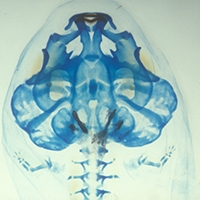Citation:
| 1.93 MB |
Date Published:
JulAbstract:
We assess cranial neural-crest cell migration and contributions to the larval chondrocranium in the phylogenetically basal and morphologically generalized anuran Bombina orientalis (Bombinatoridae). Methods used include microdissection, scanning electron microscopy, and vital dye labeling, in conjunction with confocal and fluorescence microscopy. Cranial neural-crest cells begin migrating before neural-fold closure and soon form three primary streams. These streams contribute to all cranial cartilages except two medial components of the hyobranchial skeleton (basihyal and basibranchial cartilages), the posterior portion of the trabecular plate, and the otic capsule, the embryonic origin of which is unknown. Chondrogenic fate is regionalized within the cranial neural folds, with the anterior regions contributing to anterior cartilages and the posterior regions to posterior cartilages. A neural-crest contribution also was consistently observed in several cranial nerves and the connective tissue component of many cranial muscles. Notwithstanding minor differences among species in the initial configuration of migratory streams, cranial neural-crest migration and chondrogenic potential in metamorphosing anurans seem to be highly stereotyped and evolutionarily conservative. This includes a primary role for the neural crest in the evolutionary origin of the paired suprarostral and infrarostral cartilages, two prominent caenogenetic features of the rostral skull unique to anuran larvae. Our results provide a model of the ancestral pattern of embryonic head development in anuran amphibians. This model can serve as a basis for examining the ontogenetic mechanisms that underlie the diversity of cranial morphology and development displayed by living frogs, as well as the evolutionary consequences of this diversity. (C) 1996 Wiley-Liss, Inc.
Notes:
Uq670Times Cited:62Cited References Count:108






